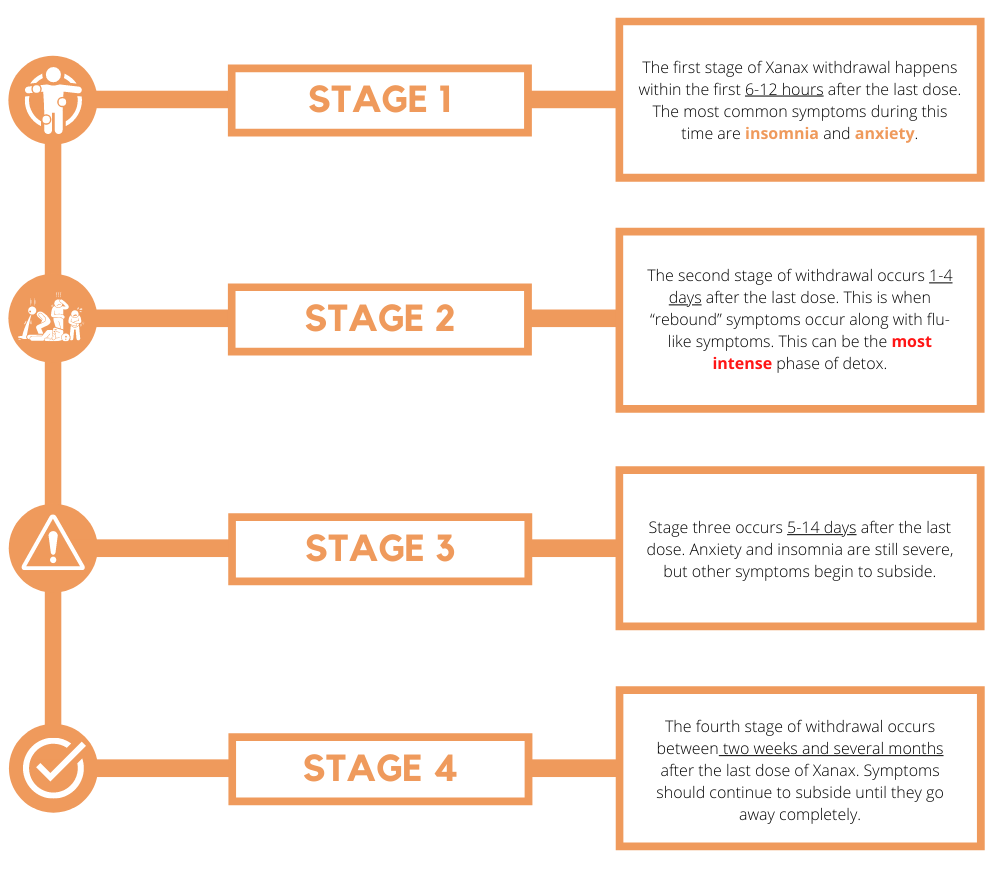Xanax (alprazolam) is a benzodiazepine medication that is used to treat anxiety and panic disorders as well as some types of seizures. It works by increasing the reuptake of gamma-aminobutyric acid (GABA) in the brain, a neurotransmitter that helps reduce feelings of anxiety, stress, and fear. With anti-anxiety and anti-seizure properties, it produces relaxing, calming effects when abused. As a result, many people abuse and get addicted to Xanax.[1,2]
Xanax addiction can cause all kinds of negative consequences in a person’s life. Sadly, these consequences don’t stop when a person stops taking the drug. Abruptly stopping Xanax after becoming addicted can lead to severe and even life-threatening withdrawal symptoms that can last for days or weeks. Although the Xanax withdrawal timeline varies from one person to the next, symptoms typically begin 6-12 hours after taking the last dose and last for up to two weeks.
People should never stop taking Xanax without speaking with their doctor or seeking help from a medical detox facility. Doing so can lead to potentially deadly complications or relapse. Instead, detox centers can help taper individuals off of the drug, keeping them safe and comfortable in the process.
How Long Does Xanax Withdrawal Last?
Xanax has an approximate half-life of 11 hours, so it takes the body 50 hours to remove the drug from the system.[3] Although this seems like a long time, Xanax actually has one of the shortest half-lives of all benzodiazepine medications. Because of its short half-life, withdrawal symptoms can appear quickly after a person misses a dose.
In totality, the Xanax withdrawal timeline lasts about two weeks. Some patients may have post-acute withdrawal symptoms (PAWS) that last for weeks or months after stopping the drug. These prolonged symptoms can be managed with the help of an addiction treatment program.
Symptoms of Xanax Withdrawal
Xanax (alprazolam) is primarily used to treat anxiety and panic disorders. Unfortunately, symptoms of anxiety and panic tend to “rebound” while individuals are detoxing from the medication. As soon as the last dose wears off, individuals may experience extreme anxiety, uneasiness, and panic.
Other psychological symptoms of Xanax withdrawal include:[4]
- Depression
- Dysphoria
- Irritability
- Paranoia
- Poor concentration
- Difficulty sleeping
- Nightmares
- Drowsiness during the day
- Agitation
- Delusions
- Hallucinations
Physical symptoms of Xanax detox include:
- Increased blood pressure
- Increased heart rate
- Muscle tension
- Restlessness
- Body aches
- Blurry vision
- Tremors
- Flu-like symptoms
- Poor coordination
- Muscle pain
- Seizures
Xanax Withdrawal Timeline
The exact duration of the withdrawal process varies from one person to the next, but it usually follows a general timeline consisting of four different stages:
- Stage 1 – The first stage of Xanax withdrawal happens within the first 6-12 hours after the last dose. The most common symptoms during this time are insomnia and anxiety.
- Stage 2 – The second stage of withdrawal occurs 1-4 days after the last dose. This is when “rebound” symptoms occur along with flu-like symptoms. This can be the most intense phase of detox.
- Stage 3 – Stage three occurs 5-14 days after the last dose. Anxiety and insomnia are still severe, but other symptoms begin to subside.
- Stage 4 – The fourth stage of withdrawal occurs between two weeks and several months after the last dose of Xanax. Symptoms should continue to subside until they go away completely.
Factors That Affect the Xanax Withdrawal Timeline
The overall duration and severity of Xanax detox will vary from one person to the next. This is because there are many different factors that dictate the drug’s withdrawal timeline. These include:
- How long the person has been taking Xanax
- How high the person’s tolerance is to the drug
- Whether or not they use Xanax along with other substances
- How old the person was the first time they used Xanax
- The method of administration (oral, snorting, etc.)
- Metabolic factors such as age, weight, height, and metabolism
- Health conditions pertaining to liver and kidney function
- Mental health conditions like anxiety, bipolar disorder, or depression
Other factors such as stress levels, hormones, and family history of addiction can all influence the symptoms and timeline during which someone experiences withdrawal.
Medical Treatment for Xanax Detox
Quitting Xanax cold turkey can put the body into a state of shock that results in life-threatening withdrawal symptoms, such as seizures. Not only that, but self-detox from Xanax is also likely to be unsuccessful. Getting through the Xanax withdrawal timeline without professional help usually ends in relapse and multiple failed attempts at getting sober.
The safest way to stop taking Xanax is to do so with the help of a medical detox center. These programs use a tapering method to slowly reduce the dose of Xanax each day, preventing severe withdrawal symptoms. Tapering off Xanax allows the body to gradually get used to functioning without it.[5]
In addition to a taper, detox programs can monitor patients’ symptoms and help prevent complications during detox. They are able to stabilize patients and prepare them to go to rehab.
Find a Xanax Detox Program in West Palm Beach Today
If you or someone you love is struggling with Xanax abuse and addiction, our detox and treatment program in West Palm Beach is here to help. We offer a range of comprehensive substance abuse treatment programs that can help you stop taking Xanax safely and learn how to stay sober in the long term. Call now to get started.
References:
















